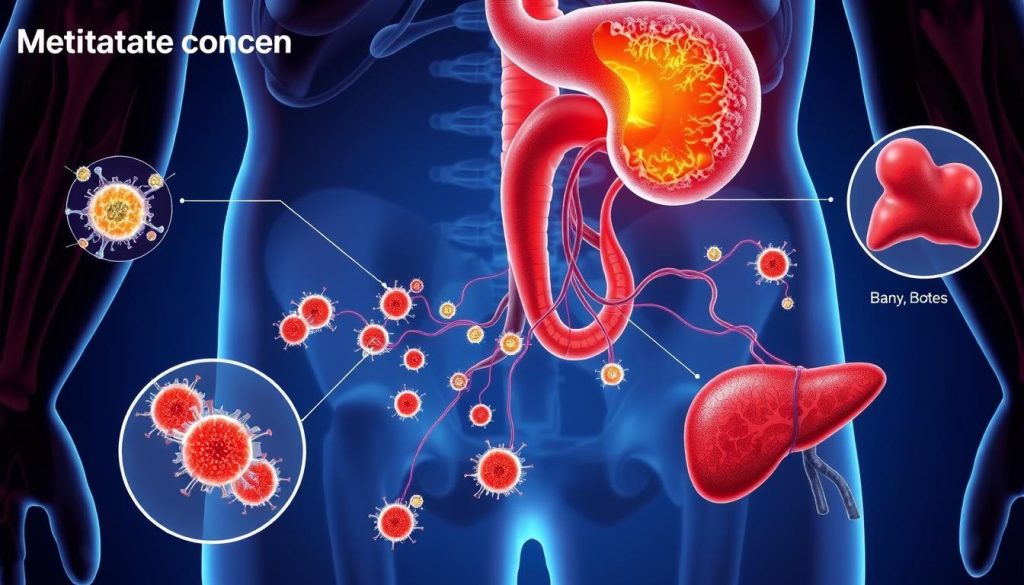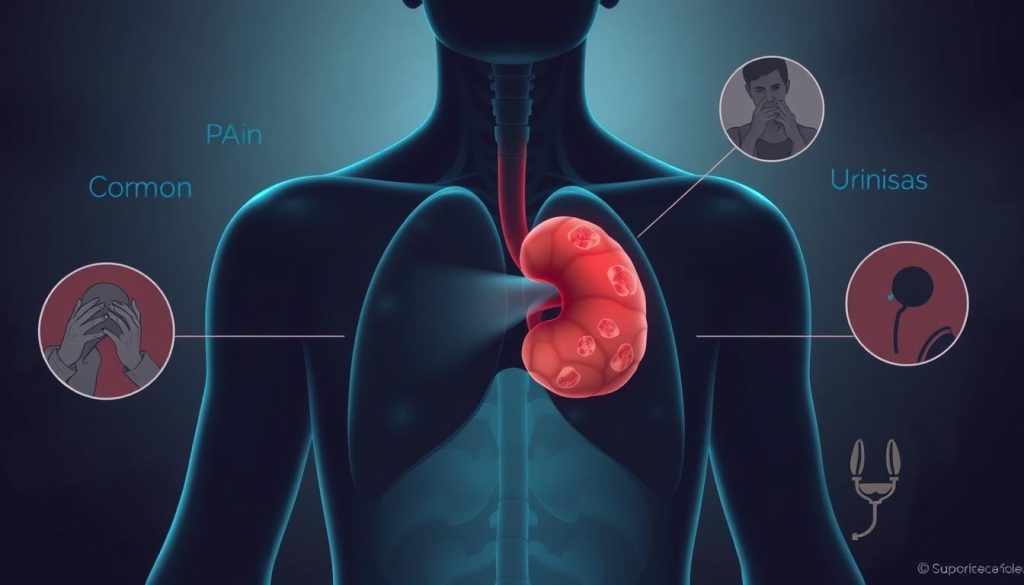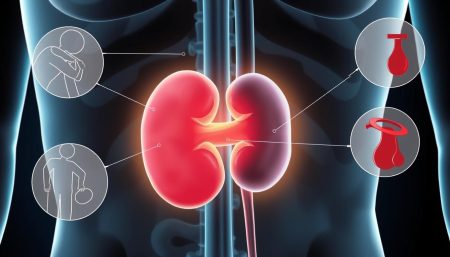Metastatic prostate cancer is the most advanced stage of prostate cancer. It happens when cancer cells spread from the prostate gland to other parts of the body. This stage, known as stage 4 prostate cancer, brings big challenges for patients and their families.
It’s important to understand metastatic prostate cancer. Knowing about it helps patients make better treatment choices and set realistic goals. We’ll look into how prostate cancer reaches this stage and what it means for those diagnosed.
We’ll also discuss the details of metastatic prostate cancer. This includes its symptoms, how it’s diagnosed, and treatment options. This information helps patients and their caregivers face this tough journey with understanding and hope.
What Is Metastatic Prostate Cancer
Metastatic prostate cancer is when cancer cells spread from the prostate gland to other parts of the body. It’s important to know about this to spot symptoms and understand the cancer’s outlook.
Definition and Basic Understanding
Metastatic prostate cancer, or stage 4, occurs when cancer cells leave the prostate. They travel through the blood or lymph system to form tumors in other organs.

How Cancer Spreads Beyond the Prostate
The spread of prostate cancer is complex. Cancer cells must break through the prostate’s outer layer. Then, they enter blood vessels or lymph nodes and travel to other parts of the body. Once there, they start growing into new tumors.
Common Sites of Metastasis
Prostate cancer often spreads to certain areas of the body. Knowing these sites helps in spotting symptoms and understanding the cancer’s prognosis.
| Site | Frequency | Potential Symptoms |
|---|---|---|
| Bones | Most common | Pain, fractures, spinal cord compression |
| Lymph Nodes | Common | Swelling, pain in pelvic or abdominal area |
| Liver | Less common | Abdominal pain, jaundice, weight loss |
| Lungs | Less common | Shortness of breath, chest pain, coughing |
Knowing these patterns helps doctors diagnose and treat metastatic prostate cancer better. This improves the cancer’s prognosis.
Signs and Symptoms of Stage 4 Prostate Cancer
It’s important to know the signs of prostate cancer early. In stage 4, symptoms can be more obvious and widespread. Spotting these signs early can help with treatment and better health outcomes.
Early Warning Signs
At first, prostate cancer symptoms might be hard to notice. Men might feel the need to urinate more often, have a weak stream, or trouble starting. It’s key to get regular check-ups if you’re at risk.

Physical Symptoms
As the disease gets worse, physical symptoms become clearer. These can include:
- Difficulty urinating or pain during urination
- Blood in urine or semen
- Erectile dysfunction
- Unexplained weight loss
These signs often lead men to see a doctor, which can lead to adiagnosis of advanced prostate cancer.
Bone-Related Symptoms
Prostate cancer often spreads to bones. Symptoms can be:
- Persistent bone pain, especially in the spine, hips, or ribs
- Increased risk of fractures
- Numbness or weakness in legs or feet
These bone issues can really affect the quality of life for those with advanced prostate cancer.
Systemic Symptoms
In stage 4, prostate cancer affects the whole body. Systemic symptoms include:
- Fatigue and weakness
- Loss of appetite
- Anemia
- Swelling in legs or feet
These symptoms show how the cancer has spread and its impact on health.
“Recognizing prostate cancer symptoms early can make a significant difference in treatment outcomes. Don’t hesitate to discuss any concerns with your healthcare provider.”
Diagnosis and Staging Methods
Getting a correct diagnosis and staging is key for knowing how prostate cancer will progress. Doctors use different tests to see how far the disease has spread. This helps them choose the best treatment.
The first test is usually a blood test for prostate-specific antigen (PSA). High PSA levels might mean cancer, but more tests are needed to be sure. A digital rectal exam lets doctors feel the prostate for any unusual areas.
If cancer is thought to be present, imaging tests are crucial. These include:
- Bone scans to check for cancer in the bones
- CT scans to look at nearby lymph nodes and organs
- MRI scans for detailed prostate and tissue images
- PET scans to find cancer spread in the body
A prostate biopsy is often done to confirm cancer and see how aggressive it is. This involves taking small tissue samples from the prostate for a closer look.
| Stage | Description | 5-Year Survival Rate |
|---|---|---|
| Stage I | Cancer confined to prostate | Nearly 100% |
| Stage II | Cancer still within prostate but more advanced | Nearly 100% |
| Stage III | Cancer spread beyond prostate but not to distant parts | Nearly 100% |
| Stage IV | Cancer spread to distant parts of the body | 30% |
Knowing the prostate cancer stages helps doctors pick the right treatment. It also gives patients an idea of what to expect. Regular check-ups are important to keep track of the cancer and adjust treatment if needed.
Treatment Options for Advanced Prostate Cancer
Patients with metastatic prostate cancer have many treatment options to choose from. The main goal is to slow the cancer’s growth, manage symptoms, and improve life quality. Let’s look at the main ways to fight this advanced disease.
Hormone Therapy Approaches
Hormone therapy is often the first choice. It lowers testosterone, which helps cancer grow. There are different medicines and surgeries to do this, helping to reduce tumors and ease symptoms.
Chemotherapy Protocols
Chemotherapy uses strong drugs to kill fast-growing cancer cells. It can be effective but may cause side effects. Doctors consider the benefits and risks before suggesting it.
Radiation Therapy Options
Radiation can shrink tumors and ease pain, especially in bone metastases. This targeted treatment can greatly improve a patient’s comfort and mobility.
Immunotherapy and Clinical Trials
Immunotherapy is a new treatment that boosts the body’s fight against cancer. Clinical trials offer access to the latest treatments. Patients should talk to their doctors about these options.
Pain Management and Supportive Care
Palliative care focuses on pain management and improving life quality. It’s a holistic approach that addresses physical and emotional needs. Regular check-ups and open communication with healthcare providers are crucial for tailored care.
FAQ
Q: What is metastatic prostate cancer?
A: Metastatic prostate cancer is stage 4 prostate cancer. It happens when cancer cells spread to other parts of the body. This stage affects bones, lymph nodes, and other organs.
Q: How does prostate cancer spread beyond the prostate?
A: Cancer cells break away from the prostate and travel through the bloodstream or lymphatic system. They settle and grow in other parts of the body, forming new tumors.
Q: What are the common sites of prostate cancer metastasis?
A: Common sites for prostate cancer metastasis are:
• Bones (especially the spine, pelvis, and ribs)
• Lymph nodes
• Liver
• Lungs
• Brain (less common)
Q: What are the symptoms of metastatic prostate cancer?
A: Symptoms include:
• Bone pain, especially in the back, hips, or pelvis
• Urinary problems (frequency, urgency, or difficulty urinating)
• Fatigue
• Unexplained weight loss
• Swelling in the legs or feet
• Weakness or numbness in the legs or feet
• Blood in urine or semen
Q: How is metastatic prostate cancer diagnosed?
A: Diagnosis involves:
• PSA (Prostate-Specific Antigen) blood test
• Imaging studies (bone scans, CT scans, MRI, PET scans)
• Biopsies of the prostate or metastatic sites
• Physical examination and medical history review
Q: What are the main treatment options for metastatic prostate cancer?
A: Treatment options include:
• Hormone therapy (androgen deprivation therapy)
• Chemotherapy
• Radiation therapy
• Immunotherapy
• Targeted therapies
• Clinical trials
• Pain management and supportive care
Q: What is the role of hormone therapy in treating metastatic prostate cancer?
A: Hormone therapy, or androgen deprivation therapy (ADT), is often the first treatment. It reduces testosterone levels or blocks its effects. This can slow down or shrink cancer growth, as prostate cancer cells rely on testosterone to grow.
Q: What is the prognosis for metastatic prostate cancer?
A: The prognosis depends on the extent of metastasis, treatment response, and overall health. While metastatic prostate cancer is not curable, many men can live for several years with proper treatment. The 5-year survival rate is about 30%, but outcomes can vary.
Q: Are there any new or emerging treatments for metastatic prostate cancer?
A: Yes, new treatments and clinical trials are ongoing. These include:
• PARP inhibitors for certain genetic mutations
• Prostate-specific membrane antigen (PSMA) therapies
• CAR T-cell therapy
• Novel hormone therapies
• Combination therapies
Patients should discuss these options with their oncologist.
Q: How important is palliative care in managing metastatic prostate cancer?
A: Palliative care is very important. It improves quality of life by managing pain, addressing treatment side effects, and providing emotional support. Palliative care is part of comprehensive cancer care.


















